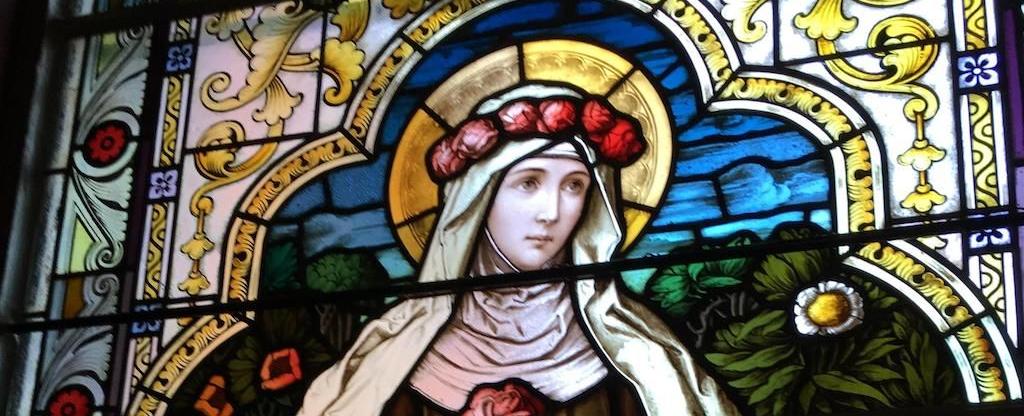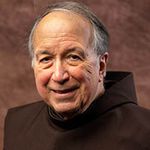Rose of Viterbo

On September 4, the Franciscan family celebrates the memory of St. Rose of Viterbo (c. 1233-1251), an audacious young Secular Franciscan woman who challenged her contemporaries as a public preacher.
Born in the city of Viterbo to a working-class family, Rose was captivated by the Franciscan friars who had established a church there. She began dressing up in their habit and devoted herself to prayer and ascetical practices in her home. She also experienced visions and gained a reputation of being able to foretell the future. To the consternation of her parents, people flocked to their home to hear Rose speak. In time, they allowed her to join the Brothers and Sisters of Penance (the Franciscan “Third Order”). Although still in early adolescence, Rose began preaching publically, girt in a Franciscan cord, leading her followers through the streets, urging people to do penance and turn their lives to God. The leaders of Viterbo were loyal to the Emperor Frederick II at a time when he was locked in conflict with Pope Innocent IV. Rose preached loyalty to the Church, and so she and her family were exiled from the city; as the political tide turned, they were allowed to return.
In her late teens, she sought admission to the local Poor Clare monastery, but the nuns refused because of her controversial reputation and the fact that her family could not provide a dowry. She continued her life of penance in her family home, where she died on March 6, 1251. Her body remains an object of great veneration in Viterbo today. Recent examination of her remains indicate that she died of a rare enlarged heart condition.
Rose was quickly acclaimed a saint by the people of Viterbo who brought her incorrupt body to the Poor Clare monastery that had refused her entry in life. Pope Innocent IV immediately began the process for her canonization but for various reasons her cause did not go forward and she was not canonized until 1457. By that time, her role as a mendicant preacher had been removed from the official biographies.
“Live so as not to fear death. For those who live well in the world, death is not frightening, but sweet and precious.” St. Rose
The image of St. Rose is from a stained glass window in the chapel of the convent of St. Rose in La Crosse, Wisconsin.
Born in the city of Viterbo to a working-class family, Rose was captivated by the Franciscan friars who had established a church there. She began dressing up in their habit and devoted herself to prayer and ascetical practices in her home. She also experienced visions and gained a reputation of being able to foretell the future. To the consternation of her parents, people flocked to their home to hear Rose speak. In time, they allowed her to join the Brothers and Sisters of Penance (the Franciscan “Third Order”). Although still in early adolescence, Rose began preaching publically, girt in a Franciscan cord, leading her followers through the streets, urging people to do penance and turn their lives to God. The leaders of Viterbo were loyal to the Emperor Frederick II at a time when he was locked in conflict with Pope Innocent IV. Rose preached loyalty to the Church, and so she and her family were exiled from the city; as the political tide turned, they were allowed to return.
In her late teens, she sought admission to the local Poor Clare monastery, but the nuns refused because of her controversial reputation and the fact that her family could not provide a dowry. She continued her life of penance in her family home, where she died on March 6, 1251. Her body remains an object of great veneration in Viterbo today. Recent examination of her remains indicate that she died of a rare enlarged heart condition.
Rose was quickly acclaimed a saint by the people of Viterbo who brought her incorrupt body to the Poor Clare monastery that had refused her entry in life. Pope Innocent IV immediately began the process for her canonization but for various reasons her cause did not go forward and she was not canonized until 1457. By that time, her role as a mendicant preacher had been removed from the official biographies.
“Live so as not to fear death. For those who live well in the world, death is not frightening, but sweet and precious.” St. Rose
The image of St. Rose is from a stained glass window in the chapel of the convent of St. Rose in La Crosse, Wisconsin.
Dominic Monti, OFM
Professor of Franciscan Research in the Franciscan Institute of St. Bonaventure University
Dominic V. Monti, OFM, is a Franciscan Friar of Holy Name Province (USA) and currently professor of Franciscan Research in the Franciscan Institute of St. Bonaventure University. He devoted the greater part of his ministry to teaching the History of Christianity, in particular the history of the Franciscan movement. He has contributed two volumes to the Works of St. Bonaventure series and is author of Francis & His Brothers, a popular history of the Friars Minor.

